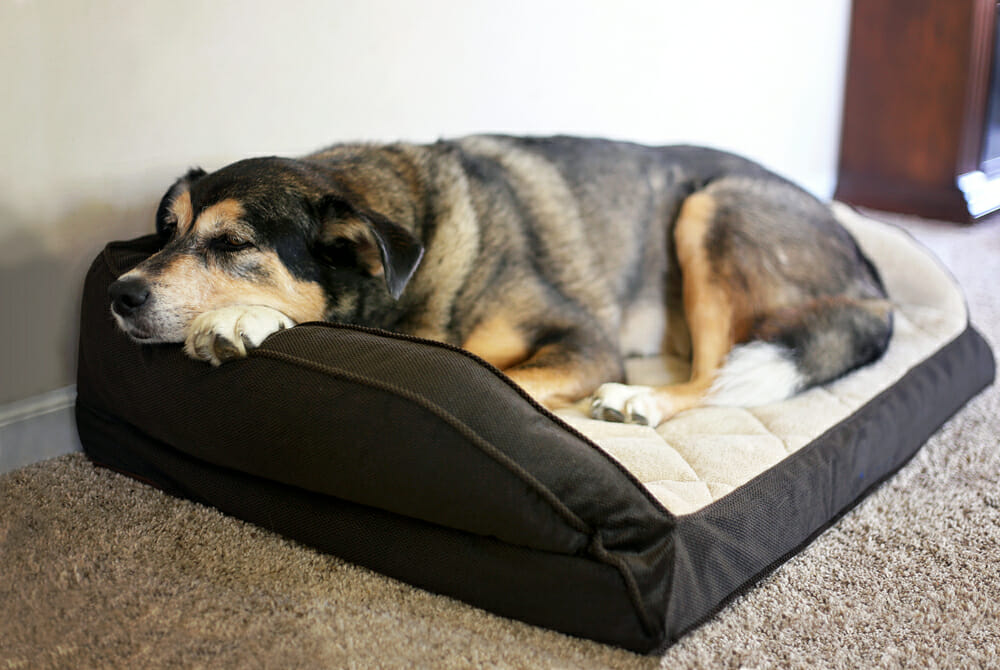Most of us know the larynx is commonly known as the voice box and is located in the throat. We know that laryngitis is a condition where one cannot speak. The larynx is not just where the sound comes from; it is, more importantly, the cap of respiratory tubing. The larynx closes the respiratory tract off while we eat and drink so that we do not inhale our food. If we need to take a deep breath, the muscles of the larynx expand and open for us. The larynx is the guardian of the airways, keeping whatever we want to swallow out and directing air in.
Dogs with laryngeal paralysis demonstrate some or all of the following signs:
- Excess panting
- Exercise intolerance
- Voice change
- Loud breathing sounds
- Respiratory gasping or distress
The usual patient is an older, large breed dog; the most commonly affected breed is the Labrador Retriever. Laryngeal paralysis does not come about suddenly. For most dogs, there is a fairly long history of panting, easily tiring on walks, or loud breathing. Ideally, the diagnosis can be made before the condition progresses to an emergency. Warm summer days and high humidity are the worst times for any respiratory condition.
It’s been suggested that hypothyroidism may be a cause of laryngeal paralysis. In fact, it is not. Hypothyroidism is associated with other neuropathies that could complicate the polyneuropathy of which laryngeal paralysis is a part. This means hypothyroidism should be identified and treated, but while improvement in weakness etc. may be seen, the laryngeal paralysis will not reverse with thyroid hormone supplementation.
Laryngeal paralysis results when the abductor muscles of the larynx cannot work properly. This means no expanding and opening of the larynx for a deep breath; the laryngeal folds simply flop weakly and flaccidly. In other words, when you need a deep breath, you don’t get one.
This can create tremendous anxiety (imagine attempting to take a deep breath and finding that you simply cannot). Anxiety leads to more rapid breathing and more distress. A respiratory crisis from the partial obstruction can emerge, creating an emergency and even death.
Conservative Treatment
Treatment of laryngeal paralysis is most likely going to require surgery, but not everyone is ready or able to provide a surgical solution for their dog. Here are some tips for non-surgical management:
- Change from collar to harness to avoid pressure on the larynx.
- Avoid heat or other situations where the dog might pant. Avoid being outside in the warmest times of the day. Air Conditioning can be a lifesaver!
- Reduce activity (also to reduce panting) and avoid wt gain.
- An anti-anxiety medication called Doxepin has been used to palliate laryngeal paralysis in patients where surgery is not an option; NSAID’s are often helpful as well.
The Crisis
If laryngeal paralysis is not treated, a respiratory crisis can emerge. In this situation, the patient attempts to breathe deeply and simply cannot, creating a vicious cycle of anxiety and respiratory attempts. The laryngeal folds become swollen, making the throat obstruction still worse. The patient’s gums become bluish in colour from lack of oxygen, and the patient begins to overheat. For reasons that remain unclear, fluid begins to flood the lungs, and the patient begins to drown (as if the laryngeal obstruction wasn’t lethal enough).
The patient must be sedated, intubated, and cooled down with water in order to survive. As soon as intubation is in place, the patient can breathe normally, oxygen can be given, and the crisis can be curtailed if it has not progressed too far. Of course, eventually, the patient will have to wake up. Corticosteroids can be used to reduce the swelling, but ideally, one of several surgical solutions is needed.
Surgical Solutions
The goal of surgery, whichever technique is used, is to relieve the airway obstruction permanently while maintaining the original function of the larynx (protection of the airways).
Laryngeal Tieback (also called Lateralization Surgery)
This has probably become the most commonly performed surgery for laryngeal paralysis. It involves placing a couple of sutures in such a way as to pull one of the arytenoid cartilages backward. By repositioning one of the arytenoids, the opening of the larynx is made larger. The main complication is that only a few millimetres of position change in the arytenoids are needed. If the cartilage is moved too much, the larynx cannot properly close and aspiration pneumonia becomes a substantial risk. Commonly these patients have a persistent cough after eating or drinking. This surgery has been associated with a 14 percent postoperative mortality rate.
Post-Operative Considerations
There are some special concerns after laryngeal surgery, regardless of the procedure:
- The patient must be restricted from barking for 2-3 weeks. Tranquillizers may be needed to effect this.
- Expect a reduced volume in the patient’s bark.
- Some gagging and coughing are normal during eating and drinking. This tends to reduce or resolve with time.
- NO SWIMMING EVER AGAIN! The patient’s airway protection is compromised with laryngeal surgery, and many dogs will swim with their mouths open. The risk of water aspiration is too great.
Aspiration Pneumonia
Nearly 25% of patients who have undergone surgery for laryngeal paralysis will develop it at some point. Pneumonia is always potentially life-threatening, and aspiration pneumonia is particularly difficult to clear since it involves large contaminated food particles in the lung. Broad-spectrum antibiotics, fluid therapy, and physical therapy are important tools, but, sadly, the underlying condition that led to the original aspiration pneumonia is likely to produce future episodes.
If you have any future questions, please don’t hesitate to give us a call.
Written by Dr. Alex Hare




